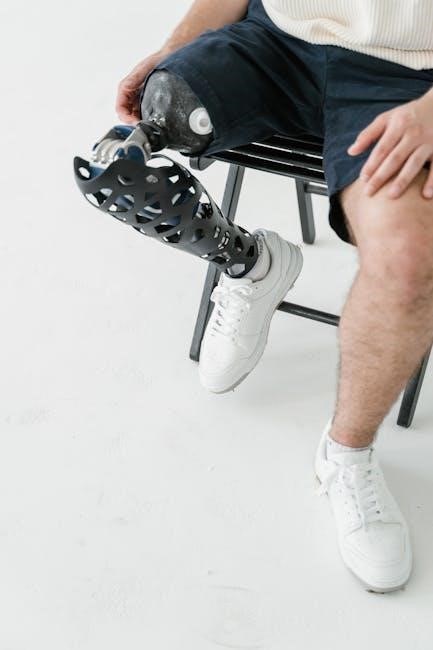Total hip replacement (THA) is an elective surgical procedure to treat arthritic hip joints, replacing the damaged joint with artificial components to alleviate pain and restore mobility․

Pre-Operative Preparation
Pre-operative preparation involves medical clearance, attending education sessions, and practicing exercises to improve mobility and strength, ensuring a smooth transition to post-surgery recovery and rehabilitation․
2․1 Importance of Pre-Rehabilitation Exercises
Pre-rehabilitation exercises are crucial for preparing the body before total hip replacement․ They improve joint mobility, strengthen surrounding muscles, and enhance balance, reducing post-operative recovery time and complications․ These exercises also help patients develop a routine, ensuring better adherence to post-surgery rehabilitation․ By targeting the hip, core, and lower extremities, pre-rehabilitation enhances functional abilities, minimizing the risk of dislocation and promoting a faster return to daily activities․ Early activation of muscles reduces atrophy and maintains flexibility, making the transition to post-surgery therapy smoother․ Overall, pre-rehabilitation exercises play a key role in optimizing surgical outcomes and improving the patient’s quality of life post-operatively․
2․2 Preparing the Home Environment
Preparing the home environment is essential for a safe and successful recovery after total hip replacement․ Clear walkways to prevent tripping, remove rugs, and secure loose carpets․ Install handrails in bathrooms and stairs for support․ Use non-slip mats in the shower or bathtub․ Elevate seating with cushions or a high chair to avoid deep bending․ Arrange daily essentials within easy reach to minimize stretching or reaching․ Consider renting a raised toilet seat or grab bars for added stability․ Ensure proper lighting throughout the home, especially in hallways and staircases․ Having a recovery area with pillows, blankets, and necessary items nearby can enhance comfort․ These modifications reduce the risk of falls and facilitate independence during rehabilitation․

Immediate Post-Operative Care
Immediate post-operative care involves monitoring for complications, managing pain, and reducing swelling․ Patients are encouraged to start mobilizing early with assistive devices to promote healing and prevent stiffness․
3․1 Initial Recovery Period
The initial recovery period after total hip replacement typically lasts 1-2 weeks․ During this time, patients are closely monitored in the hospital for complications such as infection or bleeding․ Pain management is prioritized, often through a combination of medications and ice therapy․ Swelling and bruising are common but usually subside within a few days; Early mobilization is encouraged, with patients beginning to bear weight and use assistive devices like walkers or crutches to avoid dislocation․ Breathing exercises and gentle movements are also recommended to prevent blood clots and promote circulation․ The focus is on ensuring patient comfort and safety while laying the foundation for a successful rehabilitation process․
3․2 Pain Management Strategies
Pain management after total hip replacement is crucial for a smooth recovery․ A multimodal approach is often used, combining medications, ice therapy, and nerve blocks to minimize discomfort․ Opioids and NSAIDs are commonly prescribed to control pain and inflammation․ Ice therapy can reduce swelling and numb the area, while nerve blocks may be used during or after surgery to block pain signals․ Additionally, non-pharmacological methods like deep breathing exercises and relaxation techniques can help manage pain effectively․ Patients are encouraged to follow a structured pain management plan tailored by their healthcare provider to ensure comfort and prevent complications․ Proper pain control enables early mobilization and participation in physical therapy, which are essential for successful rehabilitation․

Physical Therapy and Rehabilitation
Physical therapy and rehabilitation focus on early mobilization and strengthening exercises to restore mobility, reduce complications, and promote a safe return to normal activities after THA․
4․1 Early Mobilization Techniques
Early mobilization is crucial for recovery after total hip replacement․ Patients are encouraged to start moving within hours of surgery, using assistive devices like crutches or walkers to protect the new joint․ Gentle exercises, such as ankle pumps and heel slides, improve circulation and prevent stiffness․ Weight-bearing status varies, but most patients can partially bear weight initially․ The goal is to restore normal gait and balance progressively․ Early movement reduces complications like blood clots and joint contractures, promoting faster healing and functional recovery․ Supervised therapy ensures safety and adherence to post-operative guidelines, minimizing the risk of dislocation or injury․
4․2 Strengthening and Stretching Exercises
Strengthening and stretching exercises are essential for restoring hip function and mobility post-surgery․ These exercises target the hip muscles, core, and surrounding tissues to improve stability and range of motion․ Common exercises include hip abductions, bridging, and quadriceps sets to build strength․ Stretching focuses on the hamstrings, hip flexors, and piriformis to prevent tightness and maintain flexibility․ Patients are often prescribed a structured program, incorporating resistance bands or light weights, tailored to their progress․ Consistency in performing these exercises accelerates recovery, reduces stiffness, and minimizes the risk of complications․ Supervised physical therapy ensures proper form and progression, helping patients achieve long-term functional goals and return to daily activities safely․
Activity Modifications and Restrictions
After total hip replacement, patients must adhere to specific activity modifications and restrictions to ensure proper healing and prevent complications․ These guidelines typically include avoiding heavy lifting, bending at the hips past 90 degrees, and crossing the legs․ Patients are advised to use assistive devices like canes or walkers for balance and support during the initial recovery phase․ High-impact activities, such as running or jumping, are usually prohibited, while low-impact exercises like swimming or cycling are encouraged to promote mobility without risking joint damage․
Activity restrictions are generally lifted after 2-3 months, but patients should continue to avoid repetitive twisting or pivoting movements․ These modifications help protect the new hip joint and ensure a successful recovery․

Managing Complications and Setbacks
Complications after total hip replacement, such as infections, dislocations, or blood clots, require prompt medical attention․ Patients should monitor for signs of infection, including redness, swelling, or fever, and contact their healthcare provider immediately․ Blood clots can be prevented with compression devices or medication․ Dislocations are rare but may occur if activity restrictions are not followed․ If a dislocation happens, patients should remain calm, avoid movement, and seek emergency care․ Chronic pain or limited mobility may indicate a need for further evaluation or rehabilitation adjustments․ Setbacks, such as slower-than-expected progress, should be addressed with a healthcare provider to refine the recovery plan․ Early intervention is crucial to manage complications effectively and ensure a successful recovery․
The Role of Healthcare Providers
Healthcare providers play a critical role in guiding patients through the recovery process after total hip replacement․ They develop personalized treatment plans, monitor progress, and address any complications promptly․ Providers ensure proper wound care, manage pain effectively, and adjust rehabilitation protocols as needed․ Regular follow-ups allow them to assess healing, range of motion, and strength․ They also educate patients on activity modifications and safety measures to prevent dislocations or injuries․ By addressing patient concerns and providing evidence-based care, healthcare providers are essential in optimizing outcomes and ensuring a smooth transition back to normal activities․ Their expertise and support are vital for achieving long-term success in recovery․
Patient’s Role in Recovery
The patient plays a vital role in their own recovery after total hip replacement․ Active participation in rehabilitation exercises, as prescribed by healthcare providers, is essential to regain strength, mobility, and functionality․ Patients must adhere to activity restrictions to protect the new joint and prevent complications․ Attending physical therapy sessions, following home exercise programs, and using assistive devices correctly are critical․ Patients should also maintain open communication with their healthcare team, reporting any concerns or symptoms promptly․ Additionally, preparing the home environment for safety and accessibility can significantly aid recovery․ By taking responsibility for their care and following guidelines, patients can optimize their outcomes and achieve a faster, more successful return to daily activities and independence․
Long-Term Recovery and Outcomes
Long-term recovery after total hip replacement typically results in significant improvement in pain relief, mobility, and quality of life․ Most patients achieve full recovery within 6-12 months, with implants lasting 15-20 years or more․ Success rates are high, with over 90% of patients experiencing durable outcomes․ Proper adherence to rehabilitation protocols and activity modifications enhances long-term results․ Patients often return to normal activities, including low-impact sports, with minimal restrictions․ However, occasional discomfort or activity-related stiffness may persist․ Factors like implant durability, surgical technique, and patient compliance influence outcomes․ Regular follow-ups with healthcare providers ensure monitoring of the hip replacement and address any concerns․ Overall, total hip replacement is a highly effective procedure for restoring long-term hip function and improving overall well-being․
Total hip replacement is a highly successful procedure for addressing severe hip arthritis, offering significant pain relief and improved mobility․ The rehabilitation process, guided by structured protocols, plays a crucial role in achieving optimal outcomes․ Patient engagement and adherence to post-operative guidelines are essential for a smooth and effective recovery․ With proper care and long-term activity modifications, most patients experience durable results, with implants lasting for many years․ The collaboration between patients and healthcare providers ensures personalized treatment plans, maximizing quality of life․ Ultimately, total hip replacement is a life-changing intervention, enabling individuals to resume normal activities and enjoy improved overall well-being․
References and Further Reading
For further reading on total hip replacement rehabilitation, refer to the following resources:
- American Academy of Orthopaedic Surgeons (AAOS): Provides comprehensive guidelines and patient information on hip replacement surgery and rehabilitation․
- Mayo Clinic: Offers detailed insights into post-operative care, physical therapy protocols, and recovery tips for hip replacement patients․
- Ortho Rhode Island: Shares evidence-based rehabilitation protocols for total hip arthroplasty, emphasizing early mobilization and strengthening exercises․
- Horder Healthcare: Publishes patient-focused guides on post-surgery rehabilitation, including exercises and activity modifications․
- Salina Regional Orthopedic Clinic: Provides downloadable PDF guidelines for total hip arthroplasty rehabilitation, covering timelines and progression criteria․
These resources ensure a well-rounded understanding of the rehabilitation process following total hip replacement surgery․
